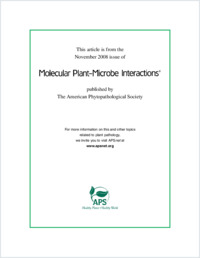Pseudomonas syringae Elicits Emission of the Terpenoid (E,E)-4,8,12-Trimethyl-1,3,7,11-Tridecatetraene in Arabidopsis Leaves Via Jasmonate Signaling and Expression of the Terpene Synthase TPS4
- Attaran, Elham Julius-von-Sachs-Institute of Biological Sciences, University of Würzburg, Germany
- Rostás, Michael Julius-von-Sachs-Institute of Biological Sciences, University of Würzburg, Germany
- Zeier, Jürgen Department of Biology, Plant Biology Section, University of Fribourg, Switzerland
-
2008
Published in:
- Molecular Plant-Microbe Interactions. - 2008, vol. 21, no. 11, p. 1482-1497
English
Volatile, low–molecular weight terpenoids have been implicated in plant defenses, but their direct role in resistance against microbial pathogens is not clearly defined. We have examined a possible role of terpenoid metabolism in the induced defense of Arabidopsis thaliana plants against leaf infection with the bacterial pathogen Pseudomonas syringae. Inoculation of plants with virulent or avirulent P. syringae strains induces the emission of the terpenoids (E,E)-4,8,12-trimethyl-1,3,7,11-tridecatetraene (TMTT), β-ionone and α-farnesene. While the most abundant volatile, the C₁₆-homoterpene TMTT, is produced relatively early in compatible and incompatible interactions, emission of both β-ionone and α-farnesene only increases in later stages of the compatible interaction. Pathogen-induced synthesis of TMTT is controlled through jasmonic acid (JA)-dependent signaling but is independent of a functional salicylic acid (SA) pathway. We have identified Arabidopsis T-DNA insertion lines with defects in the terpene synthase gene TPS4, which is expressed in response to P. syringae inoculation. The tps4 knockout mutant completely lacks induced emission of TMTT but is capable of β-ionone and α-farnesene production, demonstrating that TPS4 is specifically involved in TMTT formation. The tps4 plants display at least wild type–like resistance against P. syringae, indicating that TMTT per se does not protect against the bacterial pathogen in Arabidopsis leaves. Similarly, the ability to mount SA-dependent defenses and systemic acquired resistance (SAR) is barely affected in tps4, which excludes a signaling function of TMTT during SAR. Besides P. syringae challenge, intoxication of Arabidopsis leaves with copper sulfate, a treatment that strongly activates JA biosynthesis, triggers production of TMTT, β-ionone, and α-farnesene. Taken together, our data suggest that induced TMTT production in Arabidopsis is a by-product of activated JA signaling, rather than an effective defense response that contributes to resistance against P. syringae.
- Faculty
- Faculté des sciences et de médecine
- Department
- Département de Biologie
- Language
-
- English
- Classification
- Biological sciences
- License
- License undefined
- Identifiers
-
- RERO DOC 10753
- DOI 10.1094/MPMI-21-11-1482
- Persistent URL
- https://folia.unifr.ch/unifr/documents/300881
Statistics
Document views: 64
File downloads:
- zeier_pee.pdf: 131
